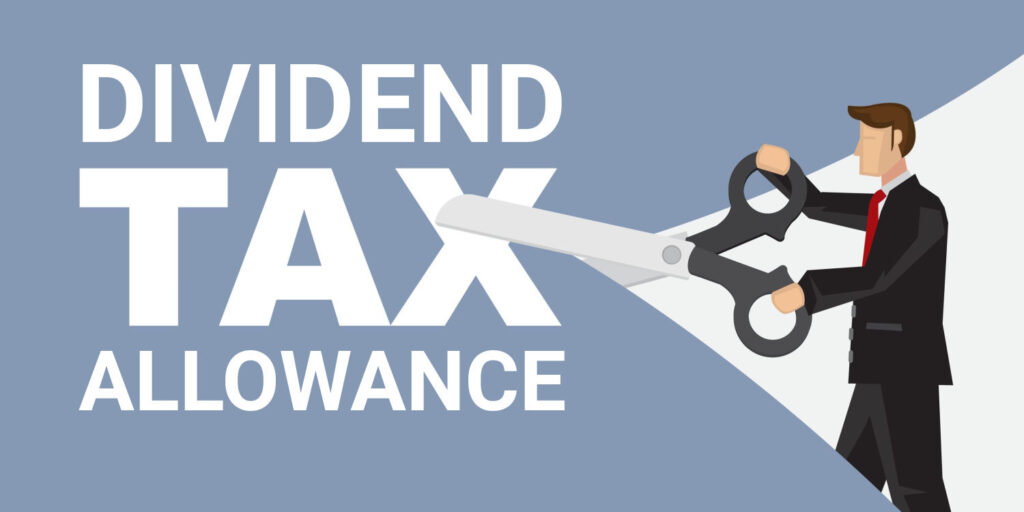On 6 April 2024, the annual dividend allowance was reduced from £1,000 to £500, which is disappointing news for shareholders. Here’s everything you need to know about this important update.
Key Takeaways
- The dividend allowance for the 2024/25 tax year is £500
- Shareholders only pay tax on dividends above the dividend allowance
- Dividend income above the allowance must be reported to HMRC following the end of the tax year
What is the dividend tax allowance?
The dividend allowance is the total amount of dividends you can receive in a year before you must start paying tax on them. It was reduced to £500 for the 2024/25 tax year – a 50% cut on the previous year’s allowance. Dividend payments that are issued through ISAs remain tax-free.
All shareholders are entitled to the dividend allowance, regardless of how much they earn in a year. Therefore, if you receive dividends of £500 or less in the tax year, you won’t pay any tax on that income.
When annual dividend income exceeds the allowance, dividend tax is payable at increasing rates based on your total annual earnings from all sources (i.e. whether you’re a basic-rate, higher-rate, or additional-rate taxpayer).
What you need to pay if you go over the dividend allowance
The amount of tax that you need to pay once you exceed the dividend allowance is connected to your Income Tax band.
To ascertain your tax band, you need to work out your total earnings for the year by adding your other sources of income (e.g. your regular salary and any other taxable earnings) to your dividend income.
Taxpayers in Scotland pay tax on dividends according to the regular UK tax bands, but Scottish Income Tax rates apply to all other sources of income.
England, Wales & Northern Ireland tax bands and dividend tax rates 2024/25
| Band | Taxable income | Tax rate | Dividend tax rate |
| Personal Allowance | Anything up to £12,570* | 0% | 0%** |
| Basic | £12,571 to £50,270 | 20% | 8.75% |
| Higher | £50,271 to £125,140 | 40% | 33.75% |
| Additional | More than £125,140 | 45% | 39.35% |
Scottish tax bands and dividend tax rates 2024/25
| Band | Taxable income | Tax rate | Dividend tax rate |
| Personal Allowance | Anything up to £12,570* | 0% | 0%** |
| Starter | £12,571 to £14,876 | 19% | 8.75% |
| Basic | £14,877 to £26,561 | 20% | 8.75% |
| Intermediate | £26,562 to £43,662 | 21% | 8.75% |
| Higher | £43,663 to £50,270 | 42% | 8.75% |
| Higher | £50,271 to £75,000 | 42% | 33.75% |
| Advanced | £75,001 to £125,140 | 45% | 33.75% |
| Top | More than £125,140 | 48% | 39.35% |
* This is the standard Personal Allowance (PA), which is the amount of income an individual can earn tax-free in a year. However, if you earn more than £100,000, your PA will reduce by £1 for every £2 of adjusted net income above £100,000. This means your PA will be zero if your income is £125,140 or more.
**If a dividend payment is your only form of income, you won’t pay any tax on your dividends until the payments surpass £13,070 in a tax year. This is the combined total of the Personal Allowance plus the £500 dividend allowance.
To give you a better idea of what you may have to pay, let’s take a look at some examples.
Example 1
For the 2024/25 tax year, you receive £10,000 in dividends. This is your only income for the year.
- The first £500 of dividend income is tax-free due to the annual dividend allowance
- The remaining £9,500 is within your tax-free Personal Allowance (£12,570)
- None of this income is taxable, so you can keep the whole £10,000
Example 2
You receive a £25,000 dividend payment. This is your only income for the year.
- £25,000 places you in the basic rate taxpayer bracket (£12,571 to £50,270)
- The first £500 is tax-free due to the annual dividend allowance
- The next £12,570 is covered by your tax-free Personal Allowance
- Your taxable income is the remaining £11,930
- You must pay 8.75% dividend tax (the basic rate) on this amount = £1,044
- Your take-home dividend income for the year is £23,956
Example 3
You receive a £15,000 dividend payment and a salary of £40,000. Combined, this takes your earnings to £55,000.
- £55,000 places you in the higher rate taxpayer bracket (£50,271-£125,140)
- The first £500 of dividend income is tax-free due to the annual dividend allowance
- £12,570 of salary income is covered by your tax-free Personal Allowance
- Your taxable income is the remaining £41,930 (£14,500 dividends plus £27,430 salary)
- You pay 20% Income Tax (the basic rate) and 8% Class 1 National Insurance contributions (NIC) on the remaining £27,430 of salary income = £5,486 Income Tax and £2,194 NIC
- You pay 8.75% dividend tax (the basic rate) on £9,770 of dividend income = £855
- The remaining £4,730 of dividend income will be taxed at 33.75% (the higher rate) = £1,596
- Your take-home income for the year is £44,869
Example 4
You’re a taxpayer in Scotland. For the 2024/25 financial year, you receive a £15,000 dividend payment and a salary of £40,000. Your combined income for the year is £55,000.
- Your salary places you in the intermediate tax band for Scottish Income Tax, but your combined earnings of £55,000 place you in the UK higher rate taxpayer bracket (£50,271 – £125,140) for dividend tax
- The first £500 of dividend income is tax-free due to the annual dividend allowance
- £12,570 of salary income is covered by your tax-free Personal Allowance
- Your taxable income is the remaining £41,930 (£14,500 dividends plus £27,430 salary)
- You will pay the following rates of Scottish Income Tax on your salary:
- 19% (the starter rate) between £12,571 and £14,876 = £438
- 20% (the basic rate) between £14,877 and £26,561 = £2,337
- 21% (the intermediate rate) between £26,562 and £40,000 = £2,822
- You’ll pay 8% Class 1 NIC on your salary above £12,570 = £2,194
- You’ll pay 8.75% dividend tax (the basic rate) on £9,770 of dividend income = £855
- The remaining £4,730 of dividend income will be taxed at 33.75% (the higher rate) = £1,596
- Your take-home income for the year is £44,758
How to minimise your dividend tax liability
There are certain strategies you can use to legally minimise the amount of tax you pay on dividends. However, we always recommend consulting an accountant or tax advisor for professional help. Doing so ensures you make the most tax-efficient decisions and remain legally compliant.
Issue shares to your spouse or partner
Suppose your spouse or civil partner has unused Personal Allowance or is in a lower Income Tax bracket than you. In that case, it may be beneficial to make them a shareholder in your limited company and pay them dividends. Doing so could maintain your household’s gross annual income while reducing your tax liability.
While HMRC has tried to legislate against such strategies in the past, it remains legal to distribute share ownership (and thus dividend income) by issuing or transferring shares to your spouse or civil partner.
Make pension contributions
Since pension contributions qualify for tax relief, setting up a pension (or making additional payments into an existing one) will reduce your taxable income. In turn, this may take you into a lower tax band and reduce the tax you pay on your dividend income.
Investing through ISAs
Dividends from shares held in stocks and shares ISAs are tax-free, making them a tax-efficient way to receive dividend income. In the current 2024/25 tax year, you can save up to £20,000 tax-free in ISAs, meaning you can receive up to £20,000 of dividend income in an ISA without any dividend tax liability.
How to pay tax on dividends
Tax on dividends is usually payable through Self Assessment. If you receive more than £10,000 in dividends, you must report the income to HMRC on a Self Assessment tax return after the end of the tax year.
For example, if you receive dividend income in the 2024/25 tax year, you have until 31 January 2026 to file a Self Assessment tax return and pay any tax you owe.
- How to register for Self Assessment
- Do I need to register for Self Assessment if I run a Ltd company?
- Most tax-efficient director’s salary and dividends for 2025-26
If you owe any tax on your dividends, the deadlines for paying your Self Assessment tax bill are usually:
- 31 January – for tax you owe for the previous tax year (this is known as a balancing payment) and your first ‘payment on account‘ (if your previous year’s bill was more than £1,000)
- 31 July for your second payment on account (if applicable)
Alternatively, if your dividend income is £10,000 or less, you can tell HMRC by:
- contacting the Income Tax helpline
- asking HMRC to change your tax code and deduct the dividend tax from your wages or pension
You do not need to tell HMRC if your dividends are within the £500 dividend allowance for the tax year.
Thanks for reading
We hope you have found this post helpful. Be sure to check the 1st Formations Blog for more limited company guidance and small business advice. Please leave a comment if you have any questions.
Please note that the information provided in this article is for general informational purposes only and does not constitute legal, tax, or professional advice. While our aim is that the content is accurate and up to date, it should not be relied upon as a substitute for tailored advice from qualified professionals. We strongly recommend that you seek independent legal and tax advice specific to your circumstances before acting on any information contained in this article. We accept no responsibility or liability for any loss or damage that may result from your reliance on the information provided in this article. Use of the information contained in this article is entirely at your own risk.














Join The Discussion
Comments (4)
This is a really helpful breakdown of the new dividend allowance! I wasn’t sure how the tax brackets would affect my dividend income, so the examples are great for understanding what I might owe. Especially the difference between UK and Scottish taxes. Thanks!
Thank you for your kind comment. We’re glad you found our explanation easy to follow.
Kind regards,
The 1st Formations Team
Hi!
Thanks for the good examples here, I have a bit of a problem with the 4th scenario, It looks like after all calculations I have £45332.47 Take Home Pay, not £43,694.38 as stated in the sample, The way I have calculated is:
Wages
1.- 12,570£ Personal Allowance, 0£ tax.
2.- 2,162£ Starter Rate Scotland 19%, 410.78£ tax.
3.- 10,955£ Basic Rate Scotland 20%, 2,191£ tax.
4.- 14,313£ Intermediate Rate Scotland 21%, 3,005.73£ tax.
Dividends
5.- 1,000£ Dividend Allowance, 0£ tax.
6.- 2,660£ Basic Rate of Dividend at 8.75%, 232.75£ tax.
7.- 11,340£ Higher Rate of Dividend at 33.75%, 3827.26£ tax.
Take Home Pay: 45,332.47£
Total Tax to pay: 9,667.52£
Any help would be appreciated thanks!
Thank you for your kind message, Antonio.
You are correct in that changing the calculation to Scotland income tax will change the calculation, as you have cited in the calculation.
We trust this information is of use to you.
Kind regards,
The 1st Formations Team